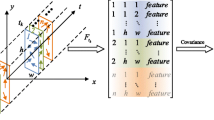Abstract
To improve the accuracy of the detection of local abnormal behavior, a novel method is here proposed. The main idea of the proposed method is described as follows: firstly, a video sequence is divided into spatio-temporal blobs; then, a statistical method based on the semi-parametric model is adopted to detect these blobs where abnormal behaviors most likely to appear; finally, maximum optical flow energy and local nearest descriptor are utilized to determinate whether these suspicious blobs really contain abnormal behaviors. The experimental results conducted on several benchmarks ademonstrate the effectiveness of the proposed method.










Similar content being viewed by others
References
Adam A, Rivlin E, Shimshoni I et al (2008) Robust real-time unusual event detection using multiple fixed-location monitors. IEEE Trans Pattern Anal Mach Intell 30(3):555–560
Breitenstein M, Grabner H, Gool L (2009) Hunting nessie-real-time abnormality detection from webcams. IEEE Conf Vis Surveill 2009:76–83
Chen X, Yuan J, Nie L, et al. (2010) TRECVID 2010 Known-item Search by NUS. IEEE Conference on Text and Video Retrieval 2010:1–12
Cheng K, Chu C (2004) Semiparametric density estimation under a two-sample density ratio model. Bernoulli 10(4):583–604
Cui X, Liu Q, Gao M (2011) Abnormal detection using interaction energy potentials. IEEE Conf Comput Vis Pattern Recognit 2011:3161–3167
Dee H and Hogg D (2004) Detecting inexplicable behaviour. British machine vision conference, 477–486
Hendel A, Weinshall D, Peleg S (2010) Identifying surprising events in videos using bayesian topic models. Asian Conf Comput Vis 6494:448–459
Hong R, Li G, Nie L et al (2010) Exploring large scale data for multimedia QA: an initial study. ACM Conf Content-Based Image Video Retr 2010:74–81
Hou A, Guo J, Wang C (2013) Abnormal behavior recognition based on trajectory feature and regional optical flow. ICIG 2013:643–649
Kim J and Grauman K (2009) Observe locally, infer globally: a space-time MRF for detecting abnormal activities with incremental updates. IEEE Conf Comput Vis Pattern Recognit 2921–2928. doi:10.1109/CVPR.2009.5206569
Lee D, Suk H, Lee S (2014) Modeling crowd motions for abnormal activity detection. IEEE Conf Adv Video Signal Based Surveill 2014:325–330
Li C, Han Z, Ye Q (2013) Visual abnormal behavior detection based on trajectory sparse reconstruction analysis. Neurocomputing 119(1):94–100
Mahadevan V, Weixin L, Bhalodia V et al (2010) Anomaly detection in crowded scenes. IEEE Conf Comput Vis Pattern Recognit 2010:1975–1981
Mehran R, Moore B, Shah M (2010) A streakline representation of flow in crowded scenes. Eur Conf Comput Vis 6313:439–452
Mehran R, Oyama A, Shah M (2009) Abnormal crowd behavior detection using social force model. IEEE Conf Comput Vis Pattern Recognit 2009:935–942
Nie L, Wang M, Gao Y et al (2013) Beyond text qa: multimedia answer generation by harvesting web information. IEEE Trans Multimed 15(2):426–441
Nie L, Wang M, Zha Z et al (2011) Multimedia answering: enriching text QA with media information. ACM SIGIR Conf 2011:695–704
Palmer J, Kreutz K, Rao B (2005) Variational EM algorithms for non-Gaussian latent variable models. IEEE Conf Adv Neural Inf Process Syst 2005:1059–1066
Shan H, Banerjee A (2011) Mixed-membership naive Bayes models. Data Min Knowl Disc 23(1):1–62
Shet V, Harwood D, Davis L (2006) Multivalued default logic for identity maintenance in visual surveillance. Eur Conf Comput Vis 3954:119–132
Wallach H (2006) Topic modeling: beyond bag-of-words. ACM Conf Mach Learn 2006:977–984
Yan Y, Ricci E, Liu G et al (2015) Egocentric daily activity recognition via multitask clustering. IEEE Trans Image Process 24(10):2984–2995
Yan Y, Ricci E, Subramanian R et al (2013) No matter where you are: flexible graph-guided multi-task learning for multi-view head pose classification under target motion. IEEE Int Conf Comput Vis 2013:1174–1183
Yan Y, Ricci E, Subramanian R et al (2014) Multi-task linear discriminant analysis for multi-view action recognition. IEEE Trans Image Process 23(12):5599–5611
Yan Y, Ricci E, Subramanian R, et al. (2015) Multi-task learning framework for head pose estimation under target motion. IEEE Trans Pattern Anal Mach Intell. doi:10.1109/TPAMI.2015.2477843
Yan Y, Yang Y, Meng D et al (2015) Event oriented dictionary learning for complex event detection. IEEE Trans Image Process 24(6):1867–1878
Zach C, Pock T, Bischof H (2007) A duality based approach for realtime TV-L 1 optical flow. Pattern Recogn 4713:214–223
Zhu X, Liu J, Wang J (2014) Sparse representation for robust abnormality detection in crowded scenes. Pattern Recogn 47(5):1791–1799
Acknowledgments
This work is supported by Postdoctoral Foundation of China under No. 2014 M550297, Postdoctoral Foundation of Jiangsu Province under No. 1302087B, Graduate Education Reform Research and Practice Program of Jiangsu Province under No. JGZZ13_041 and JGLX15_055, Graduate Research and Innovation Program of Jiangsu under No. KYLX15_0854 and No. SJZZ15_0105.
Author information
Authors and Affiliations
Corresponding author
Rights and permissions
About this article
Cite this article
Zhu, S., Hu, J. & Shi, Z. Local abnormal behavior detection based on optical flow and spatio-temporal gradient. Multimed Tools Appl 75, 9445–9459 (2016). https://doi.org/10.1007/s11042-015-3122-3
Received:
Revised:
Accepted:
Published:
Issue Date:
DOI: https://doi.org/10.1007/s11042-015-3122-3




